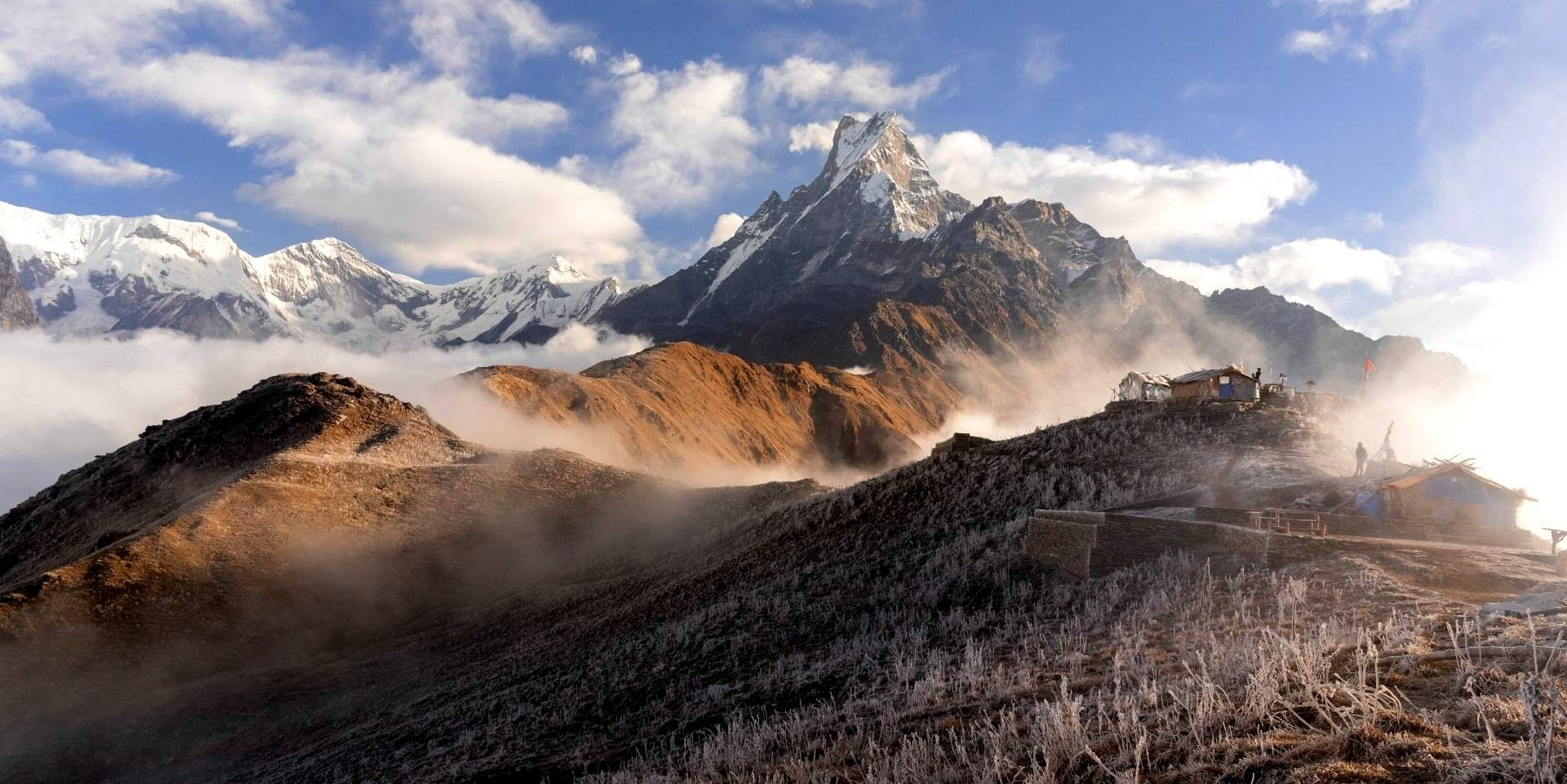Stunning Mountain Views
The Mardi Himal Trek is renowned for its stunning mountain views, offering some of the most picturesque vistas in Nepal's Annapurna region. The journey provides trekkers with an intimate experience of the grandeur of the Himalayas through its array of dramatic panoramas:
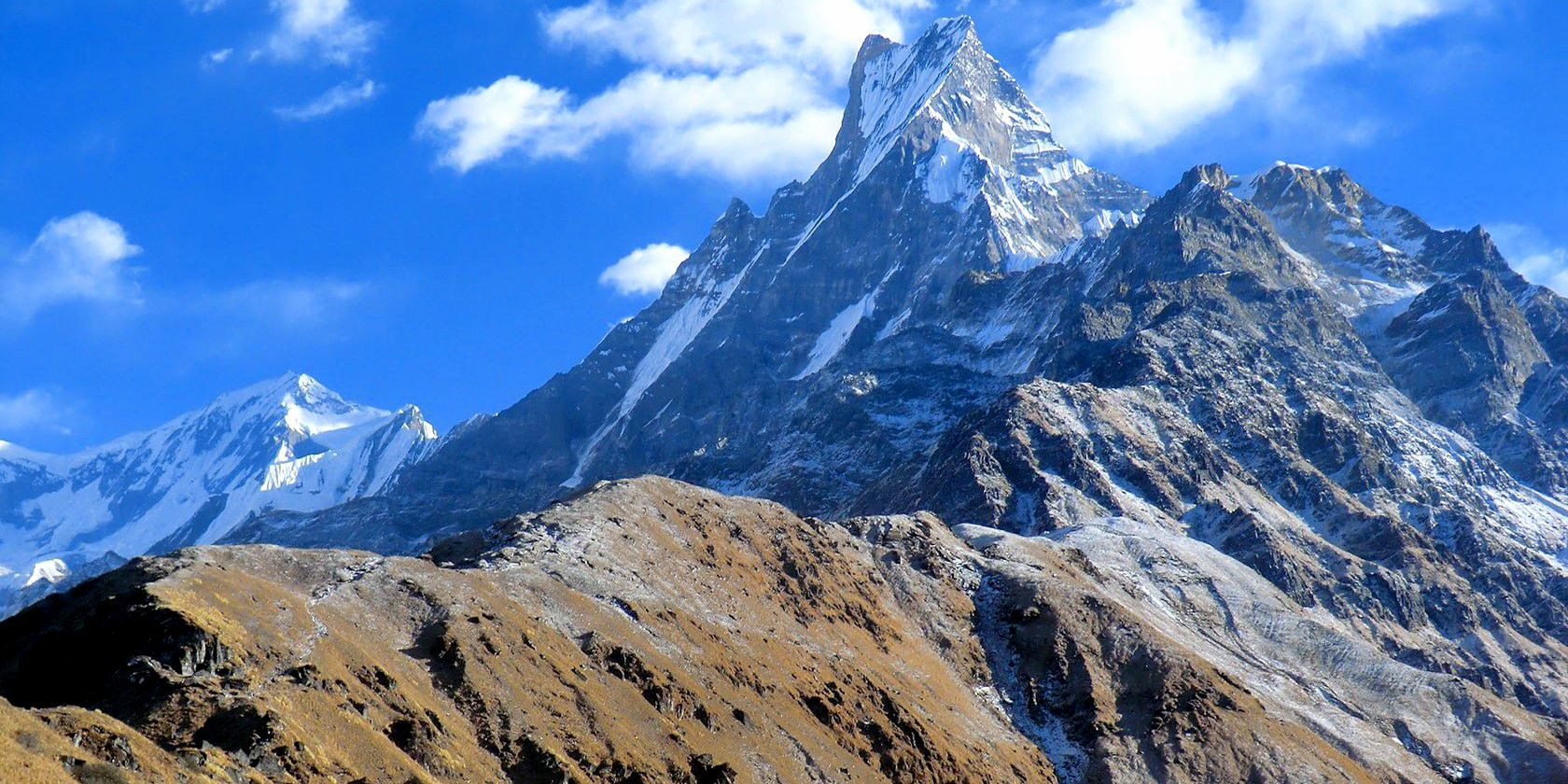
-
Mardi Himal: The trek is named after Mardi Himal, a prominent peak which forms part of the Annapurna range. Trekkers get the opportunity to see the mountain up close, particularly from the Mardi Himal Base Camp, where its impressive ridges and faces are spectacularly displayed.
-
Machapuchare (Fishtail Mountain): One of the most iconic sights on the trek, Machapuchare is revered by locals for its unique fishtail-shaped summit. The mountain remains unclimbed, adding to its mystique and allure. The view of Machapuchare is a constant companion on various segments of the trail, changing perspectives as you move along the path.
-
Annapurna South: This massive peak is part of the famed Annapurna Massif and offers breathtaking sights from various points along the trek. Its imposing presence is both inspiring and a favorite among photographers.
-
Hiunchuli: Another peak that trekkers can admire on the Mardi Himal Trek, Hiunchuli offers a rugged, heavily ridged appearance that contrasts beautifully with the softer contours of neighboring mountains.
These views are not only a treat for the eyes but also serve as a reminder of the vastness and untouched beauty of the Himalayan range. Each day of the trek promises new angles and perspectives of these majestic peaks, framed by the lush, diverse flora of the region. Whether bathed in the golden light of dawn or silhouetted against a dusky sky, the mountains along the Mardi Himal Trek offer an ever-changing, ever-enthralling spectacle that captivates and enchants trekkers.
Remote and Serene Trails
The Mardi Himal Trek is distinguished by its remote and serene trails, providing a peaceful retreat from the bustling tourist paths found in other parts of the Annapurna region. This trek offers a more intimate experience with nature, making it an ideal choice for those seeking solitude and a deeper connection with the natural world.
Characteristics of the Remote and Serene Trails
-
Less Crowded: One of the main appeals of the Mardi Himal Trek is its relatively low foot traffic compared to the more popular Annapurna Base Camp or Everest Base Camp treks. This seclusion allows trekkers to enjoy the quiet and untouched beauty of the Himalayas without the interruptions of large tour groups.
-
Unspoiled Landscapes: The trails wind through pristine forests, across sparkling streams, and over lush meadows, offering untouched natural landscapes that are both calming and invigorating. The path itself is a mix of narrow tracks that carve through dense forests and ridge lines that offer expansive views.
-
Close Encounters with Wildlife: The quieter trails increase the chances of encountering wildlife. The region is home to a variety of birds and animals, including the elusive Himalayan Monal, Nepal’s national bird, and other species that thrive far from human settlements.
-
Authentic Cultural Experiences: The trail passes through small villages and hamlets where life moves at a traditional pace, untouched by the influences of mass tourism. Trekkers have the opportunity to witness and engage with authentic local lifestyles, where traditional farming and ancient customs are still practiced.
-
Meditative Atmosphere: The tranquility of the area makes it perfect for those looking to find peace and space for reflection. The natural rhythm of walking, combined with the serene environment and spectacular views, provides a meditative experience that can be both grounding and transformative.
-
Benefits of Trekking Remote and Serene Trails: Trekking these remote paths nurtures a sense of adventure and promotes a deep personal connection with nature, which can be psychologically and emotionally refreshing. The solitude and simplicity of life along these trails can help one disconnect from the complexities of modern life and reconnect with more elemental states of being.
For trekkers who value tranquility and the beauty of nature, the Mardi Himal Trek offers an unforgettable journey through some of the most serene landscapes in Nepal. This trek is not just a physical challenge but a profound journey into the heart of the Himalayas.
Varied Ecosystems
The Mardi Himal Trek is a showcase of the remarkable biodiversity and varied ecosystems of the Annapurna region. As trekkers ascend from the subtropical lowlands to the alpine highlands, they pass through distinct ecological zones, each offering unique flora and fauna as well as dramatic changes in scenery.
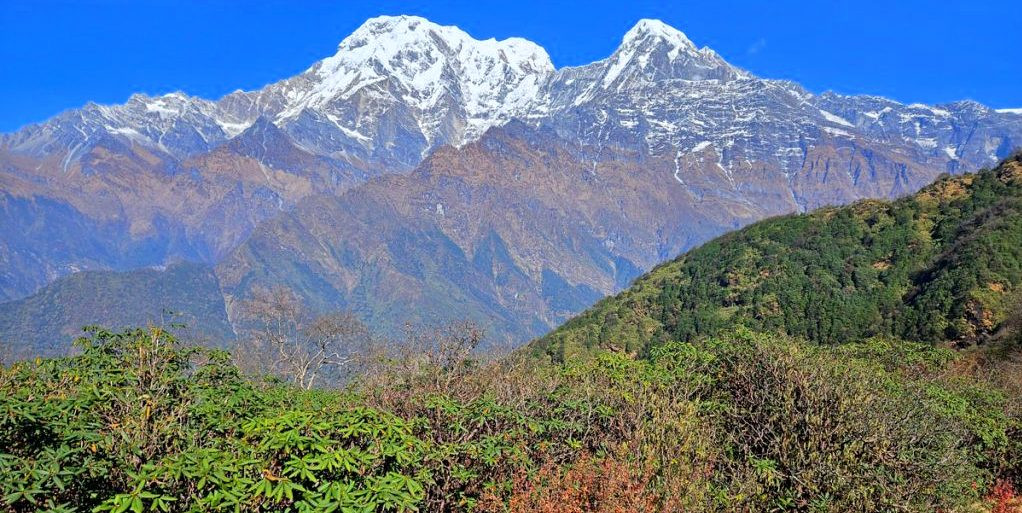
Key Ecosystems Along the Mardi Himal Trek
-
Subtropical Forests: The trek begins in subtropical forest zones characterized by lush vegetation and dense woodlands. This region is rich in biodiversity, featuring a variety of ferns, bamboo, and mixed hardwood species. It's also the habitat for numerous bird species, which add a melodious backdrop to the journey.
-
Rhododendron Forests: As the trek progresses to higher elevations, the dense subtropical forests give way to beautiful rhododendron forests. During the spring months, these forests burst into vibrant colors with blooming rhododendrons, making it a visually spectacular part of the trek. The rhododendron, Nepal’s national flower, dominates these woodlands and provides a stunning contrast to the rugged mountain backdrop.
-
Mixed Coniferous Forest: Further up, trekkers enter areas dominated by coniferous trees such as pines, oaks, and spruces. These forests are cooler and less dense, offering clearer views of the surrounding mountains. The coniferous zone is particularly enchanting with mosses and lichens draping the trees, adding an ethereal quality to the landscape.
-
Alpine and Sub-Alpine Grasslands: Above the treeline, the landscape transitions to alpine and sub-alpine grasslands. This region is characterized by open meadows and sparse vegetation, offering unobstructed panoramic views of the Annapurna range. It is a stark contrast to the lush lower regions and showcases a rugged beauty that is typical of high-altitude environments.
-
High Mountain Environment: Nearing the Mardi Himal Base Camp, the environment becomes harsher and more barren, with rocky outcrops and minimal vegetation. This high mountain ecosystem is home to specialized flora and fauna adapted to the cold and low oxygen levels. The starkness of the landscape at these altitudes is both challenging and awe-inspiring, providing a sense of the vastness and isolation inherent to the high Himalayas.
- Ecological Significance and Conservation: Each of these ecosystems plays a critical role in the local ecology and offers trekkers a chance to observe nature's adaptability and resilience. The variety in ecosystems not only enhances the trekking experience with diverse landscapes but also underscores the importance of conservation efforts to protect these fragile environments.
The Mardi Himal Trek is a profound reminder of the natural wealth of the Himalayas and the need for sustainable trekking practices to preserve this heritage for future generations. As trekkers journey through these varied ecosystems, they gain a deeper appreciation for the complex interdependencies that sustain life at different altitudes in the mountains.
Cultural Interaction
The Mardi Himal Trek not only provides stunning natural beauty but also offers enriching cultural interactions that give trekkers a glimpse into the lives of Nepal's highland communities. As the trail meanders through various traditional villages, trekkers have the unique opportunity to engage with local Gurung and Magar communities, known for their rich cultural heritage and warm hospitality.
Highlights of Cultural Interaction on the Mardi Himal Trek
-
Traditional Villages: The trek passes through quaint villages such as Pothana, Deurali, and Siding. These villages are primarily inhabited by the Gurung and Magar people, ethnic groups that have lived in these highlands for centuries. Each village presents a chance to observe traditional Nepalese mountain life, where ancient customs and practices are still part of daily living.
-
Homestays and Teahouses: Staying in homestays and teahouses along the trek allows for a deeper connection with local families. These accommodations are often simple and run by local families, providing a direct insight into the lifestyle, cuisine, and customs of the local people. It’s an immersive experience, sharing meals and evenings with hosts, often around a communal fire.
-
Local Cuisine: Food is an integral part of cultural exchange, and the Mardi Himal Trek is no exception. Trekkers can sample authentic local dishes that are staples for the mountain people, including dal bhat (lentil soup and rice), momo (dumplings), and other traditional Nepalese foods prepared with local ingredients and traditional methods.
-
Cultural Practices and Celebrations: Depending on the timing of the trek, visitors may have the chance to witness local festivals and celebrations. These events are vibrant and colorful, with traditional music, dance, and attire that reflect the rich cultural tapestry of the region.
-
Traditional Crafts: The trek also offers exposure to local crafts and industries. Many villages along the route have skilled artisans who produce handmade goods such as woven baskets, traditional knives, and hand-loomed fabrics. Purchasing these crafts can provide support to the local economy and serve as a meaningful souvenir of the journey.
-
Spiritual Sites: The route features several small shrines and chortens, reflecting the deep spiritual traditions of the communities. These sites are often beautifully decorated and serve as a focal point for local religious practices, offering an insight into the spiritual life of the community.
- Impact of Cultural Interactions: Engaging with local cultures not only enriches the trekking experience but also fosters mutual respect and understanding between trekkers and host communities. It provides economic benefits to remote areas and contributes to the preservation of cultural identities that might otherwise be at risk in a rapidly globalizing world.
The Mardi Himal Trek, therefore, offers more than just physical challenge and natural beauty; it is a portal into the heart of Nepalese culture, providing lasting memories and insights that go beyond the conventional tourist experience.
Challenging Routes
The Mardi Himal Trek is known for its challenging routes that appeal to trekkers seeking both adventure and the thrill of navigating through rugged terrain. The trek offers a variety of trails that range from moderate to difficult, providing a satisfying challenge for both seasoned trekkers and those looking to push their limits. Here’s what makes the routes of the Mardi Himal Trek notably challenging:
-
Steep Ascents and Descents: One of the key features of the Mardi Himal Trek is the steep climbs and descents that are part of the daily trekking experience. These require a good level of physical fitness and stamina. The ascent to Mardi Himal Base Camp, for example, involves a steep climb through narrow, rocky paths that can be quite demanding, especially under variable weather conditions.
-
Varied Terrain: The terrain on the Mardi Himal Trek varies significantly as trekkers ascend or descend through different ecological zones. From slippery mud trails in the forests to rocky paths in the highlands, each segment presents its own set of challenges. Such variety not only tests a trekker’s endurance but also their ability to adapt to different hiking conditions.
-
High Altitude: Reaching altitudes of up to 4,500 meters (14,763 feet) at Mardi Himal Base Camp, the trek involves gradual but significant altitude gain. Trekking at higher elevations comes with the challenge of acclimatizing to thinner air, which can affect physical performance and overall health. Proper acclimatization is crucial to manage and mitigate the risk of altitude sickness.
-
Remote Settings: The trails are remote and far removed from urban amenities, adding a layer of challenge in terms of logistics and self-sufficiency. Trekkers need to be prepared for basic conditions in teahouses and homestays, and also be ready to tackle any minor health issues or injuries with limited medical facilities available.
-
Weather Conditions: The weather in the Himalayas can be unpredictable, with sudden changes that can transform the trail conditions drastically. Trekkers might start their day under clear skies and face rain or snow by afternoon, making the trail slippery and increasing the difficulty of trekking.
-
Mental Stamina: Apart from physical challenges, the trek also tests one’s mental stamina. The combination of physical exertion, basic living conditions, and the need for constant alertness on the trail requires a strong mental commitment and resilience.
Preparing for the Challenge
To tackle these challenges effectively, it is essential for trekkers to
-
Train adequately in the months leading up to the trek, focusing on cardiovascular fitness and leg strength.
-
Invest in good quality trekking gear, including sturdy boots, warm clothing, and a reliable backpack.
-
Plan the trek with a reputable company like Relax Getaways, which ensures that all logistics are handled professionally, from expert guides who know the terrain to emergency preparedness.
The challenging routes of the Mardi Himal Trek not only promise adventure but also the reward of unparalleled natural beauty and personal accomplishment. Those who complete the trek often speak of it as a transformative experience, enhanced by the raw beauty of the landscapes and the satisfaction of overcoming the physical and mental challenges it presents.
Rich Flora and Fauna
The Mardi Himal Trek is not just a journey through stunning landscapes; it's also an exploration into a rich biodiversity hotspot within the Annapurna Conservation Area. Trekkers can witness a variety of flora and fauna, which changes as the altitude increases, providing a fascinating insight into the ecological diversity of the region.
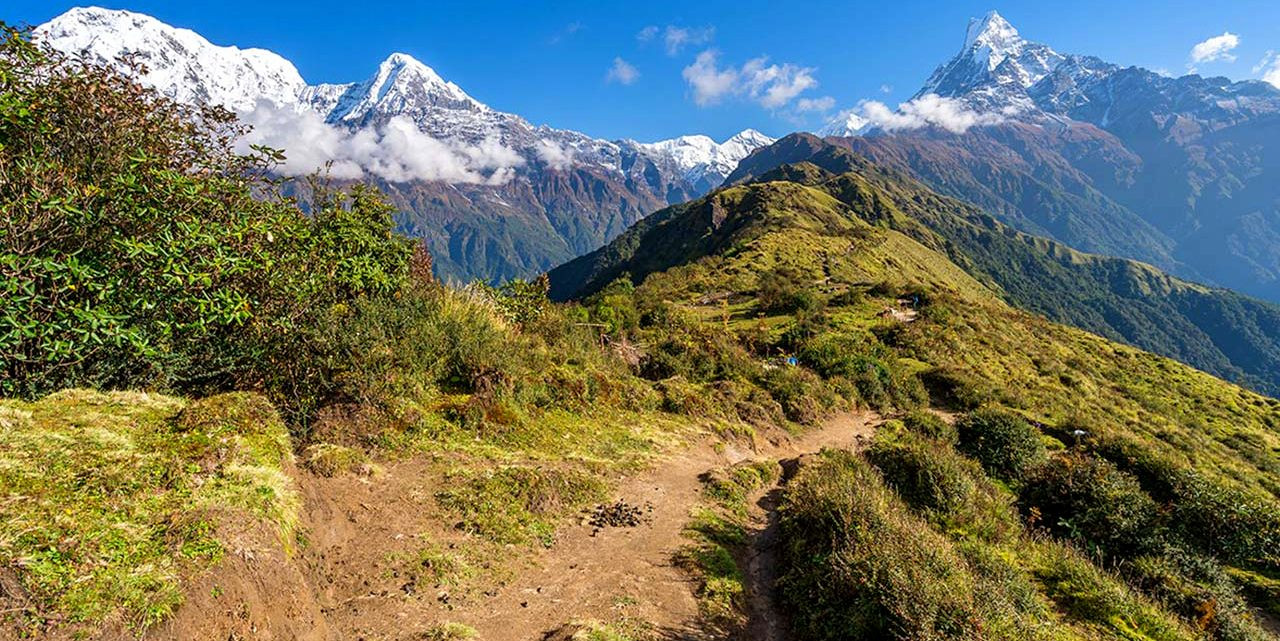
Flora on the Mardi Himal Trek
The trek begins in subtropical forest zones that are lush and dense, providing a habitat for a wide array of plant species. As trekkers ascend, they encounter:
-
Rhododendron Forests: At mid-elevations, the forests are dominated by several species of rhododendrons, Nepal’s national flower. These forests come alive with vivid colors during the spring months when the flowers are in full bloom.
-
Coniferous Forests: Higher up, the dense mixed forests transition into coniferous forests, including species such as pine, oak, and cedar. These trees are adapted to the cooler temperatures and create a starkly beautiful landscape against the mountain backdrop.
-
Alpine Scrubs and Meadows: Above the treeline, the vegetation becomes sparse and consists mainly of alpine scrubs, mosses, and grasses. These hardy plants survive the harsh, windy conditions and low temperatures, and during the spring and summer, alpine meadows bloom with a variety of wildflowers, adding splashes of color to the rugged landscape.
Fauna on the Mardi Himal Trek
The variety of ecosystems along the Mardi Himal Trek supports a diverse range of wildlife. Some of the notable species include:
-
Birds: The area is a birdwatcher's paradise, home to species such as the Himalayan Monal, Nepal’s national bird, known for its colorful plumage. Other species include the snow partridge, kalij pheasant, and various types of eagles and vultures, which are often seen soaring high above.
-
Mammals: The forests and higher grasslands are inhabited by an array of mammals. Commonly sighted animals include the Himalayan tahr, a type of wild goat, and the goral. More elusive creatures, such as the snow leopard and the red panda, inhabit the region but are rarely seen.
-
Insects and Butterflies: The trek also offers the chance to see a variety of insects and butterflies, particularly during the warmer months. The diversity of butterflies, including the large and colorful Himalayan varieties, adds an extra layer of beauty to the trek.
- Conservation Efforts: The entire region falls under the Annapurna Conservation Area Project (ACAP), which works to conserve the natural and cultural resources of the Annapurna Region. Efforts include habitat preservation, anti-poaching measures, and sustainable tourism practices to ensure that the delicate balance of this ecosystem is maintained.
The Mardi Himal Trek is an excellent opportunity for nature lovers to immerse themselves in the area's natural beauty and observe the rich biodiversity. The variation in flora and fauna as the altitude changes provides a continuous sense of discovery and wonder, making the trek not only a physical adventure but also an ecological exploration.
Sustainable and Eco-Friendly Trekking
Sustainable and eco-friendly trekking is crucial for preserving the natural and cultural landscapes of popular trekking destinations like the Mardi Himal Trek. With growing numbers of trekkers visiting these areas each year, responsible practices are essential to ensure the longevity and health of these environments. Here’s how trekkers, local communities, and trekking companies can work together to promote sustainability on the Mardi Himal Trek.
Sustainable Practices for Trekkers
-
Minimize Trail Impact: Stick to established trails to prevent soil erosion and protect native vegetation. Avoid shortcuts that can degrade the trail and surrounding habitats.
-
Manage Waste Properly: Carry out all non-biodegradable waste, and dispose of organic waste in designated areas. Many trekking groups and guides emphasize leaving no trace and may provide facilities or guidance for waste management.
-
Use Eco-Friendly Products: Opt for biodegradable soaps, detergents, and toiletries. Avoid single-use plastics by carrying reusable water bottles and bags, and consider solar chargers for electronic devices instead of disposable batteries.
-
Water Conservation: Use water sparingly and avoid contaminating streams or rivers with personal products. Water purification tablets or filters can reduce reliance on bottled water, thus minimizing plastic waste.
Role of Local Communities
-
Eco-Friendly Accommodations: Many lodges and teahouses can adopt green practices such as solar heating, water-saving toilets, and waste recycling systems to minimize their environmental footprint.
-
Local Employment: Hiring local staff not only boosts the local economy but also promotes cultural exchange and enriches the trekking experience for visitors through authentic interpersonal connections.
-
Promotion of Local Products: Encouraging trekkers to buy local crafts, foods, and services helps reduce the carbon footprint associated with transporting goods from afar and supports traditional skills and industries.
Contributions by Trekking Companies
-
Education and Awareness: Trekking companies like Relax Getaways can lead the way in educating trekkers about the principles of Leave No Trace and the importance of respecting local cultures and environments.
-
Sustainable Operations: Implementing best practices in their operations, from using eco-friendly vehicles for transport to choosing accommodation partners who prioritize sustainability.
-
Supporting Conservation Efforts: Many trekking companies engage in or support local conservation projects and initiatives, such as reforestation, wildlife protection, and trail maintenance.
Benefits of Sustainable Trekking: Sustainable trekking practices ensure that the natural beauty and cultural integrity of places like Mardi Himal are preserved for future generations. These practices not only help maintain the biodiversity and ecological health of the region but also enhance the quality of the experience for trekkers. By trekking responsibly, visitors contribute positively to the area, supporting conservation efforts and fostering economic opportunities for local communities.
Through a collective commitment to sustainability, everyone involved in the Mardi Himal Trek—from individual trekkers to large trekking companies—can help maintain its status as a stunning and vibrant trekking destination.
Mardi Himal Base Camp
The Mardi Himal Trek can be a rewarding experience, providing stunning views and intimate encounters with nature. To make the most of this adventure, it’s important to prepare well and consider some key tips to enhance your trekking experience:
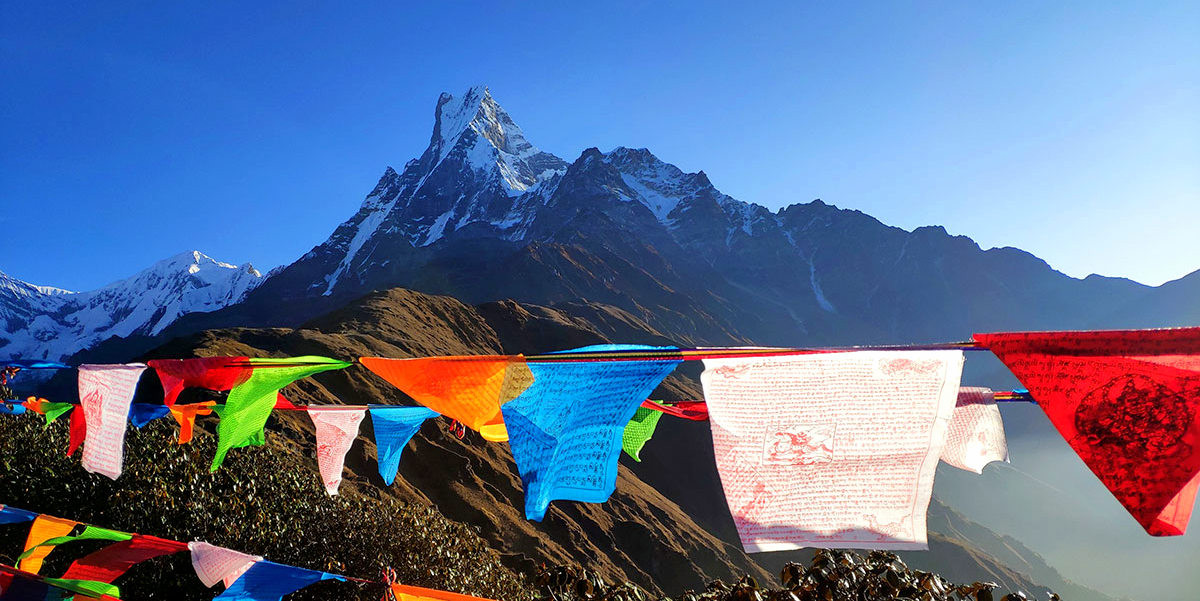
Plan Your Itinerary Carefully
-
Best Time to Visit: The optimal times to embark on the Mardi Himal Trek are during the spring (March to May) and autumn (September to November) when the weather is stable and the views are clear.
-
Duration and Pace: The trek can typically be completed in 5-7 days. Plan a pace that allows for gradual acclimatization, especially as you ascend to higher elevations.
Acquire Necessary Permits
Pack Appropriately
-
Clothing: Layering is key. Include thermal base layers, a fleece or down mid-layer, and a waterproof outer layer.
-
Footwear: Invest in a sturdy pair of waterproof trekking boots and break them in before your trek.
-
Gear: A good quality sleeping bag, a backpack with a rain cover, a water purification method, a headlamp, and trekking poles are essential.
-
Miscellaneous: Don’t forget sunscreen, lip balm, sunglasses, and a first aid kit.
Train Physically
- The trek is moderately challenging, so it’s beneficial to be in good physical condition. Engage in cardiovascular exercises such as running, cycling, or swimming, and do regular hikes to accustom your body to prolonged walking.
Stay Hydrated and Monitor Health
- Drink plenty of water throughout the trek and monitor yourself for signs of altitude sickness, which can include headaches, nausea, and dizziness. Ascend gradually and maintain a steady pace.
Hire a Local Guide
- A knowledgeable local guide can enhance your trekking experience by providing insights into the local culture and natural environment, as well as ensuring your safety and helping with route finding.
Respect Local Customs
- The trek passes through diverse communities with their cultural practices. Show respect by dressing modestly, asking permission before taking photos, and being courteous to the locals.
Travel Insurance
- Make sure you have travel insurance that covers high altitude trekking. Check that it includes medical evacuation and trip cancellation.
Mental Preparation
- Prepare yourself mentally for the trek. The days can be long, and the physical effort may be more intense than usual. A positive mindset and mental stamina will help you enjoy the journey despite its challenges.
Sustainable Trekking Practices
- Follow Leave No Trace principles: pack out all your garbage, treat water before consuming, stay on designated trails, and use eco-friendly products.
By following these tips, you'll be well-prepared for the Mardi Himal Trek, ensuring a memorable and enjoyable experience amidst some of the world’s most breathtaking landscapes.
Best Time for Mardi Himal Trek
The best time to embark on the Mardi Himal Trek, much like other treks in the Himalayas, is primarily during the spring and autumn seasons. These periods offer the most favorable weather conditions and stunning visibility, making them ideal for trekking. Here's a detailed look at what each of these seasons has to offer:
Spring (March to May)
Spring is one of the most popular times for the Mardi Himal Trek for several reasons:
-
Weather: The weather is generally stable and warmer, with clear blue skies most days, which is perfect for trekking.
-
Visibility: This season offers excellent visibility. The mountains are clearly visible, and the trails are usually free of snow.
-
Nature: Spring is also the time when the trails and forests come alive with blooming rhododendrons and other wildflowers, adding spectacular colors to the scenery.
Autumn (September to November)
Autumn is another peak season for trekking in the Mardi Himal and is considered by many as the best time to visit:
-
Weather: The post-monsoon season means the weather is dry and clear, with little to no rain, making for ideal trekking conditions.
-
Temperature: Days are comfortably warm while nights get chilly but not harsh, suitable for pleasant treks and cozy evenings.
-
Visibility: The air is crisp and clear after the monsoon rains, offering some of the best mountain views, with panoramic sights of the Annapurna range.
Other Seasons
-
Summer/Monsoon (June to early September): This season is less ideal due to the monsoon rains, which can lead to slippery trails, leeches, and obscured mountain views. However, the landscapes are lush and vibrant, and the trails are less crowded, which some trekkers may appreciate.
-
Winter (December to February): Winter trekking in Mardi Himal is feasible but comes with challenges. The temperatures can drop significantly, and snow may cover higher sections of the trail, making it more difficult and requiring proper winter gear.
Tips for Choosing the Best Time
-
Preference for Scenery: If you enjoy lush green landscapes and vibrant flora, spring might be the best time for you. For clear mountain views and dry weather, autumn will be more suitable.
-
Crowd Avoidance: Both spring and autumn see a higher number of trekkers. If you prefer solitude, consider the very early or late stages of these seasons.
-
Gear and Preparation: Ensure you are well-prepared with the appropriate gear for the specific conditions of the season you choose to trek in.
Each season offers unique experiences and challenges, so the best time for the Mardi Himal Trek ultimately depends on your personal preferences and what you want to get out of the trek.
The Mardi Himal Trek offers a distinctive and enriching journey through the quieter parts of the Annapurna region. With its breathtaking vistas of towering peaks like Mardi Himal, Machapuchare, and the Annapurna range, this trek is perfect for those seeking solitude and a moderate challenge. Ideal times for this trek are during the spring and autumn when the weather is favorable, and the natural beauty is at its peak. For an optimal experience, trekkers should prepare adequately by training, securing necessary permits, and packing appropriately. Engaging a reputable trekking company can further enhance the journey, ensuring both safety and adherence to eco-friendly practices. Ultimately, the Mardi Himal Trek is not just a physical endeavor but a profound engagement with the natural world and the vibrant culture of Nepal's highland communities. It promises lasting memories and a transformative experience for every adventurer.
FAQs for Mardi Himal Trek
Q: What is the best time to do the Mardi Himal Trek?
A: The optimal times to trek Mardi Himal are during the spring (March to May) and autumn (September to November) when the weather is stable and clear, offering the best conditions for trekking.
Q: How difficult is the Mardi Himal Trek?
A: The trek is considered moderate in difficulty. It features some steep ascents and rugged terrain, which are manageable for those with a reasonable level of fitness. Preparation and proper acclimatization are essential.
Q: What permits do I need for the Mardi Himal Trek?
A: You will need the Annapurna Conservation Area Permit (ACAP) and the Trekkers' Information Management System (TIMS) card. These can be obtained through trekking agencies or at the Nepal Tourism Board in Kathmandu or Pokhara.
Q: How long does the Mardi Himal Trek take?
A: Typically, the trek takes 5 to 7 days, depending on your itinerary and pace. Some trekkers may choose to spend extra days for acclimatization or exploration.
Q: Are there accommodation facilities along the Mardi Himal Trek?
A: Yes, the trek has basic teahouses and lodges along the route. These accommodations provide essential amenities to ensure trekkers have places to rest and recover.
Q: Is a guide necessary for the Mardi Himal Trek?
A: While not mandatory, hiring a guide is strongly recommended, especially for those unfamiliar with the region. Guides provide valuable cultural and environmental insights, enhance safety, and assist with navigation.
Q: What are the major highlights of the Mardi Himal Trek?
A: Major highlights include stunning views of Mardi Himal, Machapuchare (Fishtail Mountain), Annapurna South, and Hiunchuli. The trek also passes through diverse ecosystems and offers a chance to engage with local culture.
Q: Can I trek Mardi Himal during the winter or monsoon seasons?
A: Trekking in winter requires preparation for cold conditions and potential snow. During the monsoon, treks can be challenging due to rain and poor visibility. Spring and autumn provide more favorable conditions.
Q: What kind of food is available on the Mardi Himal Trek?
A: Teahouses along the trail typically serve Nepalese cuisine, primarily dal bhat (rice and lentils), along with a variety of other simple, nourishing dishes. Most options are vegetarian, with some places offering limited non-vegetarian dishes.
For the Nepal tour, please click here.
If you are looking for different kinds of Nepal Tours or Trekking Packages, feel free to contact us.
